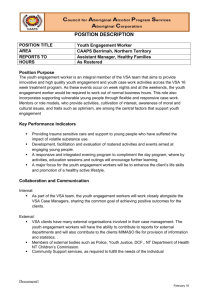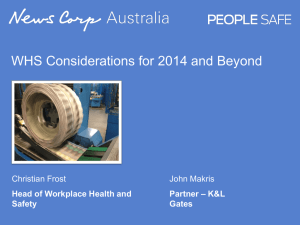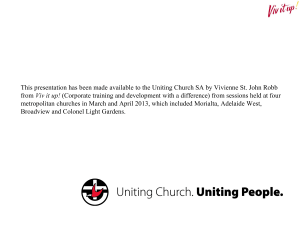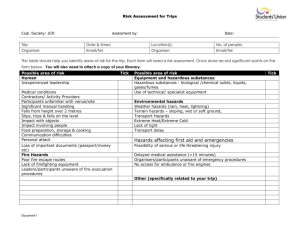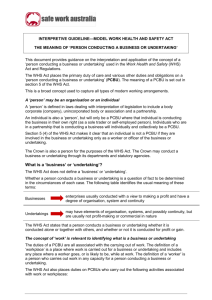Safety Signage Guide - Charles Darwin University
advertisement
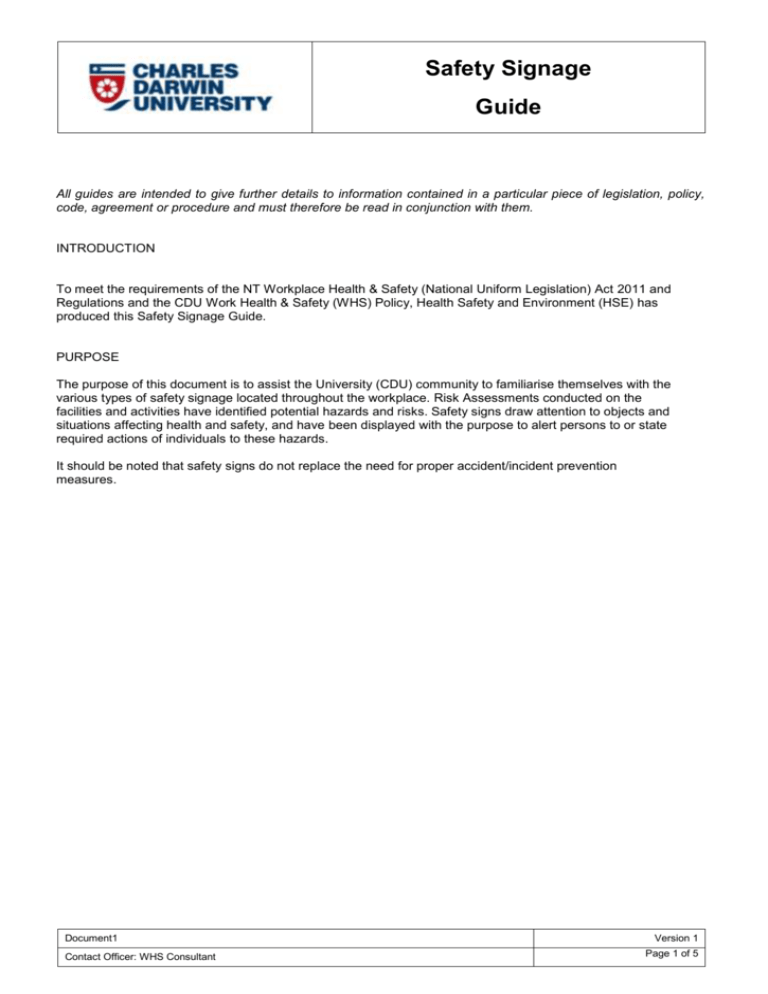
Safety Signage Guide All guides are intended to give further details to information contained in a particular piece of legislation, policy, code, agreement or procedure and must therefore be read in conjunction with them. INTRODUCTION To meet the requirements of the NT Workplace Health & Safety (National Uniform Legislation) Act 2011 and Regulations and the CDU Work Health & Safety (WHS) Policy, Health Safety and Environment (HSE) has produced this Safety Signage Guide. PURPOSE The purpose of this document is to assist the University (CDU) community to familiarise themselves with the various types of safety signage located throughout the workplace. Risk Assessments conducted on the facilities and activities have identified potential hazards and risks. Safety signs draw attention to objects and situations affecting health and safety, and have been displayed with the purpose to alert persons to or state required actions of individuals to these hazards. It should be noted that safety signs do not replace the need for proper accident/incident prevention measures. Document1 Contact Officer: WHS Consultant Version 1 Page 1 of 5 1. Abbreviations................................................................................................................................... 2 2. Relevant Definitions ........................................................................................................................ 2 3. Health and Safety Responsibilities ................................................................................................. 3 3.1 How to manage work health and safety risks ......................................................................... 3 3.2 Duty of Care ............................................................................................................................ 3 4. Classification and layout of signs .................................................................................................... 3 5. Procedure for determining type and placement of signs ................................................................ 4 6. Essential Supporting Information .................................................................................................... 5 1. Abbreviations AS/NZS CDU NUL PCBU PPE SOP WHS Australian/New Zealand Standard Charles Darwin University National Uniform Legislation Persons Conducting a Business or Undertaking Personal Protective Equipment Safe Operating Procedure Work Health and Safety 2. Relevant Definitions In the context of this document: Authorised Person means a person who has permission, qualified, licensed or competent for the task at hand. Chemical is defined as any element, chemical compound or mixture of elements and/or compounds where chemical(s) are distributed. Chemicals may be in solid, liquid, gas or plasma. Hazard means a situation or thing that has the potential to harm people, property or the environment. Hazardous chemicals are pure chemicals, or chemical mixtures that present an immediate or long term risk of injury or illness. The risk can be associated with health hazards or physiochemical hazards (e.g. flammable, corrosive, reactive, radioactive etc.). A hazardous substance can also be a dangerous good and/or a drug, poison or controlled substance. PCBU is the legal entity operating a business or undertaking. A PCBU may be an individual person or an organisation conducting a business or undertaking. It is not an individual, unless they are conducting the business in their own name as a sole trader or partner. Persons engaged solely as a worker or officer of the business or undertaking are excluded from the definition of PCBU. Plant relates to and includes any machinery, equipment, appliance, container, implement or tool, including any component or anything fitted or connected to any of those items. Plant includes items as diverse as hoists, cranes, computers, machinery, vehicles, power tools, etc. (as per Code of Practice – Managing risks of plant in the workplace). Risk is the possibility that death, injury or illness might occur when exposed to a hazard. Safety Data Sheet (SDS) is a document prepared by the vendor (manufacturer/importer/supplier) of a chemical which describes uses, chemical and physical properties, health hazard information, precautions for use, safe handling and emergency information. It is a legislative requirement for the vendor to supply a copy of the SDS for each chemical to the end user. Document1 Contact Officer: WHS Consultant Version 1 Page 2 of 5 Worker means any person carries out work in any capacity for the University, including but not limited to, University’s staff member, contractor, subcontractor and their employee, apprentice or trainee, student gaining work experience, and volunteer; Workplace means a place where work is carried out for the University and includes any place where a worker goes, or is likely to be, while at work. This may include, but is not limited to, laboratories, workshops, training rooms, on-site recreational facilities, vehicles or vessels, on field trips, in teaching facilities, in offices, in rural environments and any area of industry operations. 3. Health and Safety Responsibilities 3.1 How to manage work health and safety risks It is the responsibility of all individuals to observe and comply with the safety signage displayed throughout the University and notify management of any further hazard or risk so that the necessary controls can be implemented. Employees are encouraged to attend WHS Risk Management Training and to read the CDU Risk Management Policy. http://www.cdu.edu.au/governance/policies/pol036.pdf Work Health and Safety Policy http://www.cdu.edu.au/governance/policies/pol-044.pdf This document will provide information relating to: Duty of Care Duty to identify hazards Managing risks to health and safety Hierarchy of control measures Maintenance of control measures Review of control measures Risk management is about exercising responsibility to ensure workers and the public are properly protected. The Risk Assessment Form allows you to identify the hazard, then identify and control the associated risk. Risk Assessment Form 3.2 Duty of Care Primary duty of care – Persons conducting a business or undertaking (PCBU) must ensure, so far as reasonably practicable the health and safety of all persons engaged or influenced by the persons activities, by eliminating or minimising the exposure to hazards and risks. Workers and others – while at work, a worker must take reasonable care for their own health and safety whilst also taking all reasonable measures to ensure that their acts or omissions do not adversely affect the health and safety of other persons. The worker must comply and cooperate with any reasonable policy or procedure relating to health or safety at the workplace. 4. Classification and layout of signs Safety signs are classified and shall be used according to their function. Document1 Contact Officer: WHS Consultant Version 1 Page 3 of 5 Colour and shape requirements of signs Classification Regulatory prohibition Example Function Black legend (text or symbol) within a red circle with line through. Or a combination of both Indicates that an action or activity is not permitted White legend on a blue background. Regulatory mandatory . Indicates that an instruction must be carried out Regulatory restriction Black legend within a red circle. Place numerical or other defined limits on activities or facility uses. Hazard warning Black legend within a yellow/black bordered triangle. Warn of non-life threatening hazards or conditions Hazard danger Black legend with DANGER symbol (white on red oval) incorporated. Warn of potential life threatening hazards or conditions Emergency information White legend on green background. Indicate location or directions to emergency facilities, exits and safety equipment . Fire sign White legend on a red background. Advise the location of fire equipment, alarms and facilities. 5. Procedure for determining type and placement of signs Identify through a risk assessment what site specific signs are required (ie personal protective equipment, advice on operations, etc). Display signs where messages are legible so they can attract the attention of all concerned. The signs should be placed as close as practicable to the observer’s line of sight and should be so sighted in relation to the particular hazard as to allow the worker ample time, after first viewing the sign, to heed the warning. For example, signs against touching switches should Document1 Contact Officer: WHS Consultant Version 1 Page 4 of 5 be placed close to the switch. However, signs used on a construction site should be placed to permit the warning to be perceived before the hazard is reached, for example, adjacent to entrance. Signs should not be placed on movable objects such as doors or windows. All persons must comply with the requirements of this signage. Failure to comply with this signage is an offence against the Work Health Act. 6. Essential Supporting Information CDU Policies, Guides or Procedures Work Health and Safety Policy Emergency Management Plan Risk Management Policy Safe Operating Procedures (SOPs) Acts & Regulations Work Health and Safety (National Uniform Legislation) Act 2011 Work Health and Safety (National Uniform Legislation) Regulations Codes of Practice How to Manage Work Health and Safety Risks Hazardous manual tasks Managing noise and preventing hearing loss at work Managing the Work Environment and Facilities Australian and New Zealand Standards • AS1319.1994 – Safety signs for the occupational environment • ISO 3864 – Graphical symbols and signs • AS/NZS 31000.2009 – Risk Management – Principals and guidelines Document History and Version Control Version Date Approved Approved by Brief Description 1 14/07/2014 WHS Manager Created document Document1 Contact Officer: WHS Consultant Version 1 Page 5 of 5
